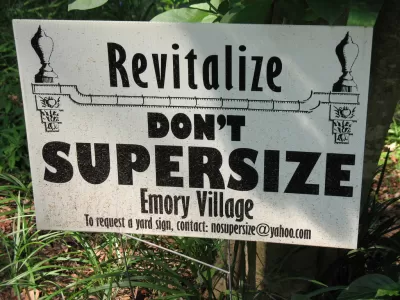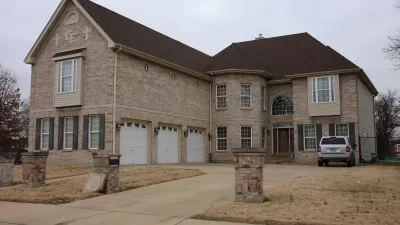Henry Grabar beckons the death of the McMansion, calling it an "American embarrassment" with no easy solution for planners.

Grabar describes the implications of the growing size of American homes, which has consistently expanded on average since the Truman Administration: "This surfeit of space is a potent symbol of the American way of life; it speaks to our priorities, our prosperity and our tendency to take more than we need. But the superlative size of our houses isn’t just a foam finger America can hold up to the world. It’s correlated with land use patterns and population density, which in turn determine the environmental impact and personal health of communities, and whether they can support a diverse range of businesses, facilities and transportation choices."
There was a temporary blip in the trend of expanding house size, however, during the most recent recession: "Between 2007 and 2010, for the first time in a half century, the average size of new U.S. homes fell by more than a hundred square feet, dropping back toward 2004 levels."
Grabar credits some critics who saw that report as good news, but the trend of constraint has not held through the economic recovery: "last year, the average size of new American houses reached an all-time high of 2,679 square feet. The increase in space per person has been even more dramatic. Between 1973 and 2013, the average American household shrank from 3.01 to 2.54 persons; new homes give Americans more than 1,000 square feet per family member, on average. That’s roughly twice as much space as we had in 1973."
Grabar goes on to describe some of the challenges that the American appetite for large homes presents for planners, especially considering that economic growth is a greater driver of urban expansion than population growth.
FULL STORY: We must kill the McMansion! Good riddance to an American embarrassment

Maui's Vacation Rental Debate Turns Ugly
Verbal attacks, misinformation campaigns and fistfights plague a high-stakes debate to convert thousands of vacation rentals into long-term housing.

Planetizen Federal Action Tracker
A weekly monitor of how Trump’s orders and actions are impacting planners and planning in America.

San Francisco Suspends Traffic Calming Amidst Record Deaths
Citing “a challenging fiscal landscape,” the city will cease the program on the heels of 42 traffic deaths, including 24 pedestrians.

Defunct Pittsburgh Power Plant to Become Residential Tower
A decommissioned steam heat plant will be redeveloped into almost 100 affordable housing units.

Trump Prompts Restructuring of Transportation Research Board in “Unprecedented Overreach”
The TRB has eliminated more than half of its committees including those focused on climate, equity, and cities.

Amtrak Rolls Out New Orleans to Alabama “Mardi Gras” Train
The new service will operate morning and evening departures between Mobile and New Orleans.
Urban Design for Planners 1: Software Tools
This six-course series explores essential urban design concepts using open source software and equips planners with the tools they need to participate fully in the urban design process.
Planning for Universal Design
Learn the tools for implementing Universal Design in planning regulations.
Heyer Gruel & Associates PA
JM Goldson LLC
Custer County Colorado
City of Camden Redevelopment Agency
City of Astoria
Transportation Research & Education Center (TREC) at Portland State University
Jefferson Parish Government
Camden Redevelopment Agency
City of Claremont





























